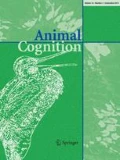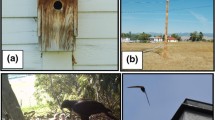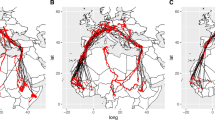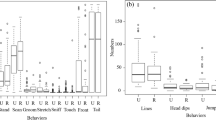Abstract
In the local population of kea in Mount Cook Village, New Zealand, some keas open the lids of rubbish bins with their bill to obtain food scraps within. We investigated the extent to which this innovation has spread in the local population, and what factors limit the acquisition of bin opening. Only five males of 36 individually recognised birds were observed to have performed successful bin opening. With one exception there were always other keas present, watching successful bin opening. Seventeen additional individuals were seen to have benefitted from lid opening. Their foraging success was less than that of the bin openers. Social status of bin openers did not differ from scrounging males. Among the individuals that were regularly seen at the site of the bins but were not successful in bin opening, social status and the ratio of feeding directly from open bins correlated with the amount of opening attempts. We conclude that scrounging facilitated certain behavioural aspects of bin opening rather than inhibiting them. The fact that only 9% of opening attempts were successful, and the long period of time required to increase efficiency in lid opening shows that mainly individual experience, and to a lesser extent insight and social learning, play key roles in acquisition of the opening technique. The results indicate that the spread of innovative solutions of challenging mechanical problems in animals may be restricted to only a few individuals.



Similar content being viewed by others
References
Barnard CJ, Sibly RM (1981) Producer and scroungers: a general model and its application to captive flocks of house sparrows. Anim Behav 29:543–550
Beggs W, Mankelow S (2002) Kea (Nestor notabilis) make meals of mice (Mus musculus). Notornis 49, 50
Bond AB, Wilson KJ, Diamond J (1991) Sexual dimorphism in the kea (Nestor notabilis). Emu 91:12–19
Caldwell CA, Whiten A (2003) Scrounging facilitates social learning in common marmosets, Callithrix jacchus. Anim Behav 65:1085–1092
Clutton-Brock TH, Albon SD, Gibson RM, Guiness FE (1979) The logical stag: adaptive aspects of fighting in red deer (Cervus elaphus L.). Anim Behav 27:211–225
Diamond J, Bond AB (1991) Social behavior and the ontogeny of foraging in the kea (Nestor notabilis). Ethology 88:128–144
Diamond J, Bond AB (1999) Kea, bird of paradox: the evolution and behavior of a New Zealand parrot. University of California Press, Berkley, Los Angeles, London
Diamond J, Bond AB (2004) Social play in kaka (Nestor meridionalis) with comparison to kea (Nestor notabilis). Behaviour 141:777–798
Fritz J, Kotrschal K (1999) Social learning in common ravens, Corvus corax. Anim Behav 57:785–793
Funk MS (1996) Spatial skill development in Golden-crowned parakeets (Cyanoramphus auriceps): a Piagetian assessment. Bird Behav 11:91–104
Gajdon GK, Fijn N, Huber L (2004) Testing social learning in a wild mountain parrot, the kea (Nestor notabilis). Learn Behav 32:62–71
Giraldeau L-A, Lefebvre L (1986) Exchangeable producer and scrounger roles in a captive flock of pigeons: a case of the skill pool effect. Anim Behav 34:797–803
Giraldeau L-A, Lefebvre L (1987) Scrounging prevents cultural transmission in food-finding behaviour in pigeons. Anim Behav 35:387–394
Gossette RL (1968) Examination of retention decrement explanation of comparative successive discrimination reversal learning by birds and mammals. Percept Mot Skills 27:1147–1152
Haemig PD (1989) A comparative experimental study of exploratory behavior in Santa Cruz Island and mainland California scrub jays Aphelocoma coerulescens. Bird Behav 8:32–42
Higgins PJ (1999) Handbook of Australian, New Zealand and Antarctic birds. Oxford University Press, Oxford
Huber L, Taborsky M, Rechberger S (2001) Social effects on object-exploration in keas. Anim Behav 62:945–954
Jackson JR (1969) What do keas die of? Notornis 16:33–44
Jarret M, Wilson K-J (1999) Seasonal and diurnal attendance of kea (Nestor notabilis) at Halpin Creek rubbish dump, Arthur's Pass, New Zealand. Notornis 46:273–286
Johnston R (1999) The Kea (Nestor notabilis): A New Zealand problem or problem solver? M.Sc. thesis, University of Canterbury, Christchurch, New Zealand
Keller R (1975) Das Spielverhalten der Keas (Nestor notabilis Gould) des Züricher Zoos. Zeitschrift für Tierpsychologie 38:393–408
Klein ED, Zentall TR (2003) Imitation and affordance learning by pigeons (Columbia livia). J Comp Psychol 117:414–419
Kothbauer-Hellman R (1990) On the origin of a tradition: milk bottle opening by titmice (Aves, Paridae). Zool Anz 255:353–361
Kubat S (1992) Die Rolle von Neuigkeit, Andersartigkeit und sozialer Struktur für die Exploration von Objekten beim Kea (Nestor notabilis). PhD thesis, University of Vienna, Vienna, Austria
Kummer H, Goodall J (1985) Conditions of innovative behaviour in primates. Philos Trans Royal Soc Lond 308:203–214
Laland KN (2004) Social learning strategies. Learn Behav 32:4–14
Lee P (1991) Adaptations to environmental change: an evolutionary perspective. In: Box HO (ed) Primate responses to environmental change. Chapman & Hall, London, pp 39–57
Lefebvre L (2000) Feeding innovations and their cultural transmission in bird populations. In: Heyes CM, Huber L (eds) The evolution of cognition. MIT Press, Cambridge, pp 311–328
Lefebvre L, Bolhuis J (2003) Positive and negative correlates of feeding innovation in birds. In: Reader SM, Laland KN (eds) Animal innovation. Oxford University Press, Oxford, pp 39–61
Lefebvre L, Gaxiola A, Dawson S, Timmermans S, Rozsa L, Kabai P (1998) Feeding innovations and forebrain size in Australasian birds. Behaviour 134:1003–1017
Lefebvre L, Nikolakakis N, Boire D (2002) Tools and brains in birds. Behaviour 139:939–973
Marriner GB (1908) The kea: a New Zealand problem. Marriner Brothers, Christchurch
Matsuzawa T, Biro D, Humle T, Inoue-Nakamura N, Tonooka R, Yamokoshi G (2001) Emergence of culture in wild chimpanzees: education by master-apprenticeship. In: Matsuzawa T (ed) Primate origins of human cognition and behavior. Springer-Verlag, Tokyo, pp 557–574
Petite O, Desportes C, Thierry B (1992) Differential probability of “coproduction” in two species of macaques (Macaca tonkeana, M. mulatta). Ethology 90:107–120
Pfeffer K, Fritz J, Kotrschal K (2002) Hormonal correlates of being an innovative graylag goose, Anser anser. Anim Behav 63:687–695
Povinelli DJ (2000) Folk physics for apes. Oxford University Press, New York
Reader SM, Laland KN (2002) Social intelligence, innovation and enhanced brain size in primates. Proc Natl Acad Sci USA 99:4436–4441
Reader SM, Laland KN (2003) Animal innovation: An introduction. In: Reader SM, Laland KN (eds) Animal innovation. Oxford University Press, Oxford, pp 3–35
Rogers EM (1995) Diffusion of innovations. Free Press, New York
Sasvàri L (1985) Keypeck conditioning with reinforcement in two different locations in trush, tit, and sparrow species. Behav Proc 11:245–252
Spence KW (1937) Experimental studies of learning and higher mental processes in infra-human primates. Psychol Bul 34:806–850
Timmermans S, Lefebvre L, Boire D, Basu P (2000) Relative size of the hyperstriatum ventrale is the best predictor of feeding innovation rate in birds. Brain Behav Evol 56:196–203
Thorpe WH (1956) Learning and instincts in animals. Methuen, London
Tomasello M (1990) Cultural transmission in the tool use and communicatory signalling of chimpanzees? In: Parker ST, Gibson KR (eds) Language and intelligence in monkeys and apes: comparative developmental perspectives. Cambridge University Press, Cambridge, pp 271–311
Tomasello M (1998) Emulation learning and cultural learning. Behav Brain Sci 21:703–704
Vickery WL, Giraldeau L-A, Templeton JJ, Kramer DL, Chapman CA (1991) Producer, scroungers, and group foraging. Am Nat 137:847–863
Visalberghi E, Limongelli L (1994) Lack of comprehension of cause-effect relation in tool-using capuchin monkeys Cebus apella. J Comp Physiol 108:15–22
Webster SJ, Lefebvre L (2001) Problem solving and neophobia in a Passeriforme-Columbiforme assemblage in Barbados. Anim Behav 62:23–32
Winkler H, Leisler B (1999) Exploration and curiosity in birds: functions and mechanisms. In: 22nd international ornitholical congress, Birdlife South Africa, Durban, Johannesburg, pp 915–932
Wyles JS, Kunkel JG, Wilson AC (1983) Birds, behaviour, and anatomical evolution. Proc Natl Acad Sci USA 80:4394–4397
Acknowledgements
We are grateful for the assistance and support of the Department of Conservation of New Zealand, especially Ray Bellringer, Phil Crutchley and Kerry Weston from the Mount Cook Area Office and Andy Grant from the Christchurch Conservancy Office. We also thank DOC volunteers from the Mount Cook Visitor Centre, and Rachel Johnston and Miriam Studer for their help in the field, Hans Winkler for comments on the manuscript, Miriam Locher and Jonathan Daisley for improving the English. This study was financed by the Austrian Science Fund (BIO P15027). Banding permission was received from the Department of Conservation of New Zealand (CHH 12/129 and CA/282/FAU).
Author information
Authors and Affiliations
Corresponding author
Rights and permissions
About this article
Cite this article
Gajdon, G.K., Fijn, N. & Huber, L. Limited spread of innovation in a wild parrot, the kea (Nestor notabilis). Anim Cogn 9, 173–181 (2006). https://doi.org/10.1007/s10071-006-0018-7
Received:
Revised:
Accepted:
Published:
Issue Date:
DOI: https://doi.org/10.1007/s10071-006-0018-7




